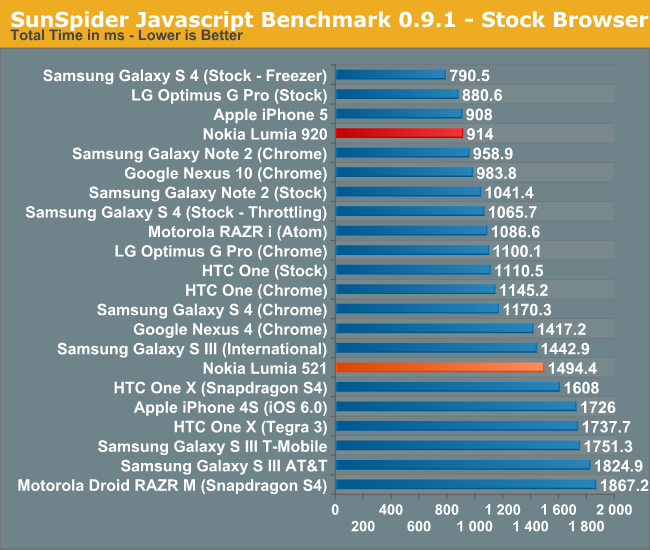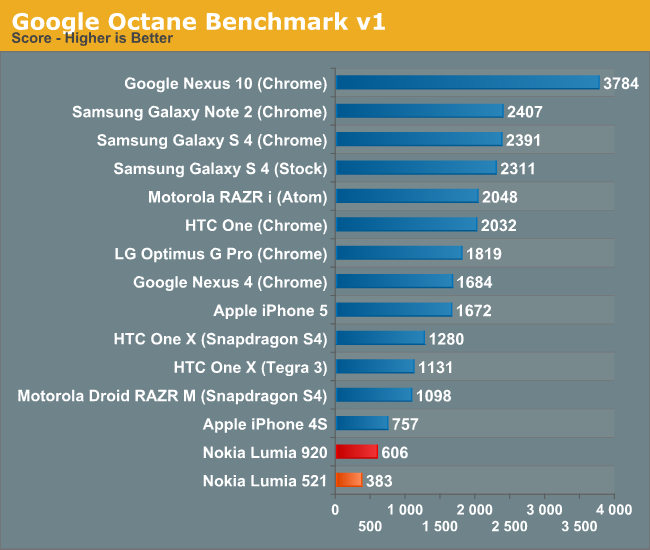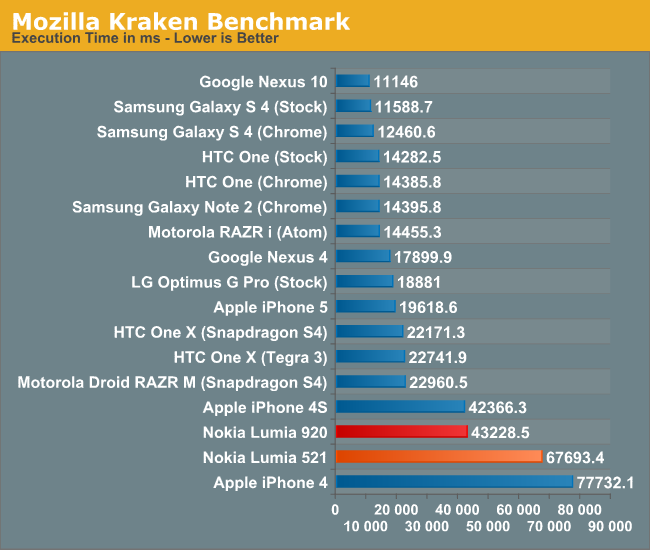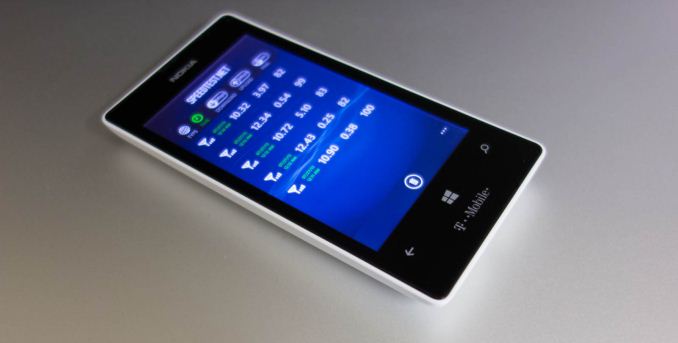Nokia Lumia 521: Quality Smartphone on an Extreme Budget
by Vivek Gowri on August 8, 2013 1:08 AM EST- Posted in
- Smartphones
- Nokia
- Mobile
- windows phone 8
- Lumia 520
- Lumia 521
Our smartphone benchmarks are centered around browser-based tests, and this is one area that really shows how far behind Internet Explorer 10 Mobile is relative to the mobile versions of Safari and Chrome. The other part of this is looking at Krait 200 at 1GHz versus the higher-clocked parts we see in the more expensive Windows Phones, which allows us to look at relative performance on the same software platform.


 Sunspider performance is actually quite good, especially compared to other Krait 200-based devices like the One X and AT&T Galaxy S3. Where it falls off is in everything else—Kraken and Octane performance is just horrendous in comparison to the modern smartphone platforms. I didn’t think it was actually possible to see numbers that high in the Kraken benchmark until I ran it a half-dozen times on my 521 review unit as well as a friend’s Lumia 920. Microsoft clearly optimized for Sunspider, as we’ve seen over the years, and while that lets them stay competitive in that one benchmark, it doesn’t really mean anything as far as having decent or even acceptable browser performance. It’s just sad.
Sunspider performance is actually quite good, especially compared to other Krait 200-based devices like the One X and AT&T Galaxy S3. Where it falls off is in everything else—Kraken and Octane performance is just horrendous in comparison to the modern smartphone platforms. I didn’t think it was actually possible to see numbers that high in the Kraken benchmark until I ran it a half-dozen times on my 521 review unit as well as a friend’s Lumia 920. Microsoft clearly optimized for Sunspider, as we’ve seen over the years, and while that lets them stay competitive in that one benchmark, it doesn’t really mean anything as far as having decent or even acceptable browser performance. It’s just sad.
Between the 920 (MSM8960, so dual-core Krait 200 @ 1.5GHz and Adreno 225) and the 521, there’s a definite performance delta. Obviously, this comes through in roughly 50% faster benchmark numbers across the board, but in day to day use, it mostly makes itself felt in slower application loading and multitasking/task switching, which is also related to having just 512MB RAM instead of the 1GB of the 920. Multitasking in Windows Phone has never really sat well with me, because it’s not really multitasking in the traditional sense—the need to completely close and rehydrate tasks makes resuming applications exceedingly slow. Microsoft has always seemed to have an issue with app load times with ARM devices—this has been true since day one with Windows Phone, and is a problem with Windows RT tablets too—so the resulting combination can really kill any desire to run more than one task on your phone at a time.
I couldn’t run GFXBench (DXBenchmark) on the 521 because it didn’t meet the 1GB RAM requirement necessary to run the benchmark. I actually wasn’t even aware that GFXBench had such a requirement in place until I tried to install it on the 521. In the grand scheme of things, I suppose it doesn’t matter too much—we’re pretty familiar with Adreno 305 by now, and it seems to be the go-to GPU for Qualcomm’s new series of dual-core Krait 200 SoCs. In a platform that deemphasizes silicon performance in the end user experience as much as Windows Phone seems to, I’m not sure that the performance delta between this and Adreno 225 makes too much of a difference, particularly with a far lower-res screen. We’re starting to see the more 3D intensive games require 1GB of memory to run, so this isn’t the device for the hardcore gamers. It does fine with the typical slate of casual games though—Fruit Ninja, Angry Birds, and the like.
The air interface is probably something you could point to and say is a bit lacking—in this day and age, dual carrier HSPA+ is almost an expectation on T-Mobile and international non-LTE devices. But honestly, you don’t end up missing it much. T-Mobile’s HSPA+ network is quite robust both in Seattle as well as in Silicon Valley, the two places I spent time testing the 521, so 10+ Mb/s was basically the norm.
I couldn’t figure out how to get the Windows Phone SpeedTest app to email a CSV of the test results, so no graphs with binned speed tests like we have on Android reviews. We’ve had a lot of experience with T-Mobile’s HSPA+ network over the years though, and it tends to be very good in most metropolitan areas. Obviously, there’s a significant jump in speed between HSPA+ and LTE, but the real-world difference between single and dual-carrier HSPA+, at least on T-Mobile, seems to be much harder to discern perceptively. The lack of DC-HSPA+ is still a bit of a disappointment, but I’m not nearly as cut up over it as I was when I saw it on the specsheet.











116 Comments
View All Comments
USGroup1 - Thursday, August 8, 2013 - link
I'm sorry but your browser tests and conclusions are beyond stupid. Your Sunspider test result clearly shows that the slowest Windows phone 8 device has a faster browser than some Android devices with much more powerful SoC."Microsoft clearly optimized for Sunspider, as we’ve seen over the years, and while that lets them stay competitive in that one benchmark, it doesn’t really mean anything as far as having decent or even acceptable browser performance. It’s just sad."
Wow, just wow, so they optimized their browser for Sunspider test to make it look good, lol pity they didn't do it for Google Octane Benchmark right?
MrSpadge - Thursday, August 8, 2013 - link
It's well known tast companies optimize for Sunspider so much that the score doesn't correlate with real world performance any more. Not saying this isn't true for the other benchmarks as well.. but don't weight Sunspider scores too heavily.Maybe Mozilla should port Firefox to Win Phone instead of trying to build an entire new OS?
InsGadget - Thursday, August 8, 2013 - link
In general, web pages work fine on my L920, even full desktop ones. I'd like to see some real-world tests instead of these canned benchmarks, anyways, since they can be easily gamed.Myrandex - Friday, August 9, 2013 - link
I agree my Lumia 920 handles pretty much any website I can throw at it with no issues. The only ones that I have trouble with are ones that are flash based (very rare) or ones not designed for touch screens (which would affect all platforms, such as websites with menus that require you to hover a mouse over...come on realize how popular touch screens are and get rid of that stuff web devs!)Flying Goat - Friday, August 9, 2013 - link
You can't really port Firefox to Win Phone any more than you can to iOS. Microsoft won't let third party browsers use their own JIT Javascript compiler, so would have to be either very slow, or an IE wrapper. They also won't have access to the functionality needed to set up a secure sandbox. See http://blog.mozilla.org/blog/2012/05/09/windows-on...madmilk - Thursday, August 8, 2013 - link
Most JITs are so-called "tracing" JITs -- they optimize at runtime. However, optimization by the JIT is not free, so it only makes sense to do it when there's a real need. Sunspider's tests are so short that browsers often don't bother, resulting in suboptimal scores.This can be hacked around for a significant increase in scores (or the test can be modified -- there's a modified Sunspider test that runs each test 50 times), but Sunspider is so far from a realistic Javascript workload that such a hack would likely cause extra time and power consumption in other tasks. Additionally, Sunspider doesn't do anything to evaluate other parts of the browser like DOM, which very often is the bottleneck in large Javascript applications.
cheshirster - Friday, August 9, 2013 - link
I agree, and that is unexpected on Anandtech. IE on 521 is performing really well in real-world compartions to low and middle price androids.savagemike - Thursday, August 8, 2013 - link
So - could I just pick one of these up on Amazon and use it with an MVNO of AT&T?notposting - Thursday, August 8, 2013 - link
AT&T has the 520 available as a GoPhone, might be a better choice (probably need to check data bands, locking).A5 - Thursday, August 8, 2013 - link
Yeah, the 520 is a better option if you're using an AT&T MVNO. 521 just gets you 21mbps on T-Mo bands.